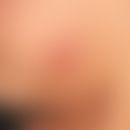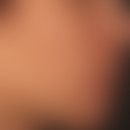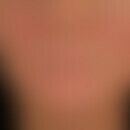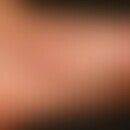Synonym(s)
HistoryThis section has been translated automatically.
Fulton, 1968
DefinitionThis section has been translated automatically.
Chronic recurrent, predominantly centrofacially localized folliculitis caused by Gram-negative pathogens.
You might also be interested in
PathogenThis section has been translated automatically.
ClassificationThis section has been translated automatically.
Type I: is caused by Enterobactericeae and Pseudomonas aeruginosa
Type II: is triggered by Proteus spp.
EtiopathogenesisThis section has been translated automatically.
Displacement of the normal bacterial flora of the skin by gram-negative bacteria, triggered by long-term antiseptic local therapy mostly in acne vulgaris or rosacea. The clinical picture can also be complicated after epilation.
ManifestationThis section has been translated automatically.
Predominantly occurring in men with strong seborhoea and preceding antimicrobial local or systemic therapy.
LocalizationThis section has been translated automatically.
Centrofacial, upper lip, area around the nostril, later chin and mouth area.
ClinicThis section has been translated automatically.
Recurrent appearance of pale yellow follicular pustules and red papules on an inflammatory reddened background.
Frequently severe seborrhoea; see also organ transplants, skin changes.
Type I: Predominantly perinasal localisation of the efflorescences
Type II: Predominantly nasolabial and perioral localization of the deep-seated, acne-conglobata-like inflammatory nodes.
HistologyThis section has been translated automatically.
Follicular abscesses without comedones.
DiagnosisThis section has been translated automatically.
Differential diagnosisThis section has been translated automatically.
Acne vulgaris: Picture of the typical acne with pubescent onset of symptoms such as seborrhea, centrofacially accentuated comedones, papules and pustules. Mostly further infestation of acne-typical locations!
Folliculitis simplex barbae: Succulent erythema with numerous, partly confluent, follicularly bound pustules; later honey yellow crusts. Painful and burning, especially when shaving. Mostly distributed over a large area, clearly follicularly accentuated with pointed conical follicular papulo-pustules. Negative fungal culture. Eosinophilic, sterile pustulosis (eosinophilic, pustular folliculitis): Due to the distribution pattern, only the infantile form is of importance in differential diagnosis. Mainly boys (5 times more frequently than girls) at the age of 5-10 months are affected. Disseminated, very itchy and reddened papules and plaques with development of sterile pustules. Confluence to larger foci is possible, also anular and polycyclic foci with central regression and peripheral progression may occur. Histology is diagnostic!
Folliculitis barbae candidamycetica (Candida folliculitis): Visible are small follicular papules and papulo-pustules, also confluent, more itchy than painful, hair may be missing in the lesional area. Culture from smear material and inoculation culture from depilated hairs. On rice agar typical cultures develop within 24 h at 22 degrees C.
Tuberculosis cutis colliquativa: Rare; eminently chronic disease; usually several globular, subcutaneous nodules covered by livid red skin. Later softening, perforation and fistulation or ulceration. Healing with the formation of funnel-shaped scars as well as bead, tip and bridge scars. Recurrent nodule eruptions.
Actinomycosis: Very rare; the infection spreads from the depth of the lower jaw to the skin. Fever and local pain may be accompanying symptoms. Very coarse, blue-red, infiltrated indurations and nodules with a tendency to ulceration or melting with a tendency to fistula and marked scarring. Often adhesions in the surrounding tissue. In the exiting pus macroscopically recognizable, 0.2-0.5 cm large, irregularly shaped, yellowish, solid grains ( drusen) can already be seen. No spontaneous healing.
Folliculitis decalvans (see also Folliculitis sycosiformis atrophicans) Rather rare differential diagnosis of follicular inflammation in the beard area. Eminently chronic clinical picture characterised by gradually spreading, scarred hair loss. Initially disseminated, small, follicular papules, later pustular transformation, crust formation. Peripheral progression of the foci, central scarred healing. Irregularly shaped scar foci with small, irreversible hair loss result. Formation of tuft hairs (typical).
External therapyThis section has been translated automatically.
Avoid cosmetics and skin irritations (no ointments and creams).
Instead, disinfectant solutions like polihexanide (Serasept, Prontoderm), diluted potassium permanganate solution(light pink), quinolinol solution(e.g. quinosol 1:1000) or keratolytic solutions such as 3-5% salicylic acid spirit(salicylic acid acne spirit 5 or 10% (NRF 11.23.) or 3-5% external agents containing benzoyl peroxide(e.g. acne fugue oxide mild 3%, acne oxide 5%). Use syndets for cleaning.
Shavers should be regularly disinfected with isopropanol 70%.
Internal therapyThis section has been translated automatically.
Systemic retinoids such as isotretinoin (e.g. isotretinoin-ratiopharm; acne normin) 0.5-1 mg/kg bw/day for several months.
In persistent cases, combination with glucocorticoids in medium dosage, e.g. 40-60 mg/day prednisolone equivalent over 10-14 days.
Systemic antibiotics are increasingly being avoided, since, in addition to unsatisfactory results, recurrences frequently occur after discontinuation.
Only if impetigo contagiosa-like staphylogenic infections occur under retinoid therapy should the retinoid be temporarily discontinued and systemic or external antibiotics should be administered after an antibiogram.
Progression/forecastThis section has been translated automatically.
LiteratureThis section has been translated automatically.
- Boni R, Nehrhoff B (2003) Treatment of gram-negative folliculitis in patients with acne. At J Clin Dermatol 4: 273-276
- Durdu M et al (2013) First step in the differential diagnosis of folliculitis: cytology. Crit Rev Microbiol 39:9-25
- Jansen T et al (1994) Gram-negative folliculitis. A diagnostic and therapeutic challenge. MMW 136: 93-96
- Lehrhoff S et al (2012) Serratia marcescens folliculitis and concomitant acne vulgaris. Dermatol Online J 18:19
- Neubert U et al (1999) Bacteriologic and immunologic aspects of gram-negative folliculitis: a study of 46 patients. Int J Dermatol 38: 270-274
- Raia DD et al (2015) Citrobacter koseri folliculitis of the face. Infection PubMed PMID: 25630477.
Incoming links (13)
Folliculitis superficial; Gram-negative folliculitis; Gram-negative folliculitis after depilation; Organ transplants, skin changes; Pseudofolliculitis barbae; Pseudomonas infections; Quinolinol sulphate monohydrate solution 0,1 % (nrf 11.127.); Rosacea fulminans; Rosacea gramnegative; Rosacea papulopustulosa; ... Show allOutgoing links (24)
Acne (overview); Actinomycosis; Antibiogram; Antibiotics; Antiseptic; Benzoyl peroxide; Candida folliculitis; Contagious impetigo; Folliculitis barbae; Folliculitis decalvans; ... Show allDisclaimer
Please ask your physician for a reliable diagnosis. This website is only meant as a reference.





